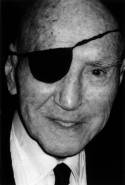



Gurdjieff International Review
For William Segal
1904–2000
by David Appelbaum
William Segal taught and embodied a threefold life. Theosopher, artist, and man of the market—in the competitive world of New York publishing—he showed an enterprising mind early and soon achieved professional recognition and lasting wealth as a self-made business man. As an artist, he developed an appreciation for the enigma of self-portraiture and, across the centuries, took Rembrandt as his master. He depicted himself in dozens of canvases and sketches, primarily to study what took place as he did so. To see and be seen simultaneously, he felt, leads toward Essence—toward what truly is, no more, no less—by way of a kind of Zen seeing that he had encountered in the company of Soen Roshi and D. T. Suzuki over the years. That no-mind state, in which inner disharmonies quieten and silence prevails “by still waters,” orients his look as he gazes back at us from his canvases and drawings.
When speaking of the search for the Absolute Self, he drew from many traditional and literary sources: the Upanishads, the Old and New Testament, Eckhart, Shakespeare, and, especially, Gurdjieff and Ouspensky, whom he had known. The Work, for him, is ever expanding, lawfully, on its own, as emanations from its origin gain energy and strength. It encompasses more as finer, more penetrating vibrations spread over more phenomena. This was his expansive vision of consciousness.
The Work, as he conveyed it, seeks awakening to a force of uncompromising rigor and precision. Only in this fashion is one’s presence the master of the situation yet still a servant of God. Ultimately, he taught, the atom of Hydrogen 1—the divine spark in the soul, as Eckhart says—must prevail. The more diligently and creatively one seeks it out in its eternally new and present form, the more complete a human being one may become.
He practiced an inner flexibility that featured becoming aware of authentic novelty whenever it appears and however it appears, in visual art, music, and dance. All the evidence indicates that he began this practice in the publishing office.
He was a man of mystery. His thought loved nothing better than paradox, to which he gave a Socratic turn. He enjoyed leading you—the participant in a conversation, the reader—into an aporia. His favorite question was “Who are you?” He felt that to say anything is a lie and that the real truth is silent. His writings, largely notes, transcripts, brief tracts, and poetic invocations, all point in that direction along the inner way.
At the same time, his special task expressed itself as a striving to become a “man for all seasons,” with its required mastery of the moment in which one must meet the challenge of opposing forces, ever stronger. This alone, he found, strengthens the center as well as the desire for Self. He himself had come across sensitivity to the needs of the situation, whatever it might be, and he helped others to learn. He retained the attitude of a learner as opposed to a teacher—an endearing quality in a guide. He personified that role for many people across many walks of life, some famous and powerful.
What impressed some was his love of language and his ability to coin new words in order to enliven tired school jargon. Noumenal, the mind-body complex, active-passive attention, and the myth of ego exemplify this aspect of his approach. At times he would reach past the boundaries of spoken language to retrieve or coin terms that seemed florid at the time—yet one remembers them still. Not potential, but “potentiation.” There were many others. If the word was odd and grand enough, one could slip off it into the reality toward which it pointed.
Above all, Bill Segal revered the mystery of life as an artist and teacher. His love for it is generously expressed in the stunning variety of his life work.



~ • ~
David Appelbaum is Professor of Philosophy at State University of New York, New Paltz. He is editor of SUNY’s Western Esoteric Traditions Series and of Parabola: The Magazine of Myth and Tradition. His writings include Everyday Spirits, The Stop, Disruption, the forthcoming The Delay of the Heart, as well as Real Philosophy, with Jacob Needleman.
|
This webpage © 2000 Gurdjieff Electronic Publishing Featured: Fall 2000 Issue, Vol. IV (1) Revision: October 1, 2000 |